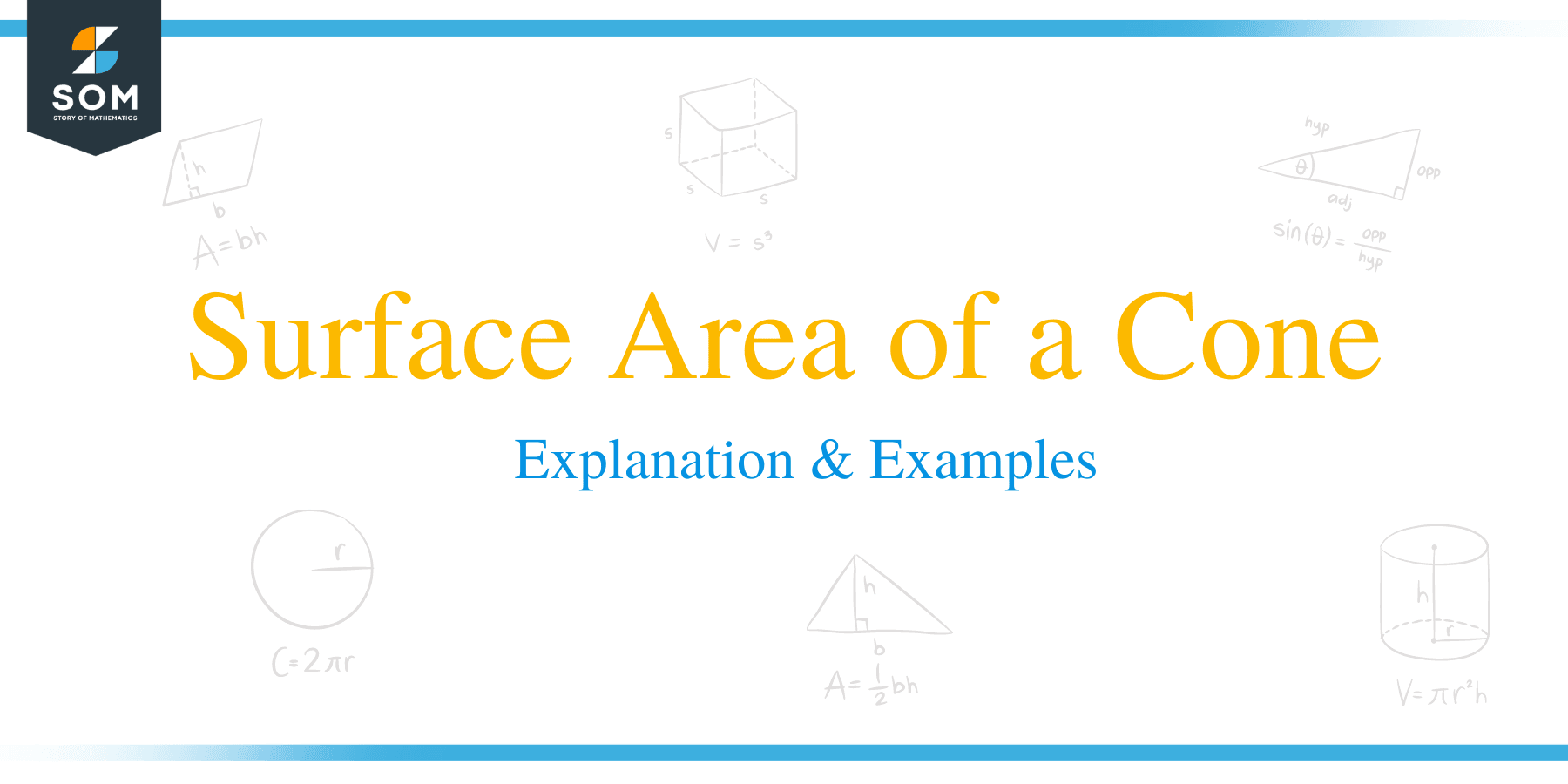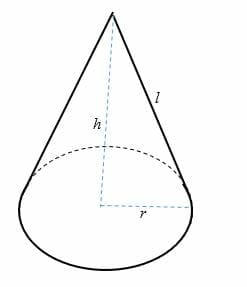- Home
- >
- Surface Area of a Cone – Explanation & Examples
JUMP TO TOPIC
Surface Area of a Cone – Explanation & Examples
 Cone is another important figure in geometry. To recall, a cone is a three-dimensional structure having a circular base where a set of line segments, connecting all of the points on the base to a common point called the apex. It is shown in the figure below.
Cone is another important figure in geometry. To recall, a cone is a three-dimensional structure having a circular base where a set of line segments, connecting all of the points on the base to a common point called the apex. It is shown in the figure below.

The vertical distance from the base center to the apex of a cone is the height (h), while the slant height of a cone is the length (l).
The surface area of a cone is the sum of the area of the slanted, curved surface and area of the circular base.
In this article, we will discuss how to find the surface area by using surface area of a cone formula. We will also discuss the lateral surface area of a cone.
How to Find the Surface Area of a Cone?
To find the surface area of a cone, you need to calculate the cone’s base and the lateral surface area.
Since the base of a cone is a circle, then the base area (B) of a cone is given as:
Base area of a cone, B = πr²
Where r = the base radius of the cone
Lateral Surface Area of a Cone
The curved surface of a cone can be viewed as a triangle whose base length is equal to 2πr (circumference of a circle), and its height is equal to the slanted height (l) of the cone.
Since we know, the area of a triangle = ½ bh
Therefore, the lateral surface area of a cone is given as:
Lateral surface area = 1/2×l×2πr
By simplifying the equation, we get,
The lateral surface area of a cone, (LSA) = πrl
Surface area of a cone formula
The total surface area of a cone = Base area + latera surface area. Therefore, the formula for the total surface area of a cone is represented as:
The total surface area of a cone = πr2 + πrl
By taking πr as a common factor from RHS, we get;
Total surface area of a cone = πr (l + r) ………………… (Surface area of a cone formula)
Where r = radius of the base and l = slant height
By Pythagorean Theorem, the slant height, l = √ (h2 + r2)
Solved Examples
Example 1
The radius and height of a cone are 9 cm and 15 cm, respectively. Find the total surface area of the cone.
Solution
Given:
Radius, r = 9 cm
Height, h = 15 cm
Slant height, l = √ (h2 + r2)
l = √ (152 + 92)
= √ (225 + 81)
=√306
= 17.5
Thus, slant height, l = 17.5 cm
Now substitute the values into the surface area of a cone formula
TSA = πr (l + r)
= 3.14 x 9 (9 + 17.5)
= 28.26 x 157.5
= 4,450.95 cm2
Example 2
Calculate the lateral surface area of a cone whose radius is 5 m and slant height is 20 m.
Solution
Given;
Radius, r = 5 m
Slant height, l = 20 m
But, the lateral surface area of a cone = πrl
= 3.14 x 5 x 20
= 314 m2
Example 3
The total surface area of a cone is 83.2 ft2. If the slant height of the cone is 5.83 ft, find the radius of the cone.
Solution
Given;
TSA = 83.2 ft2
Slant height, l = 5 .83ft
But, TSA = πr (l + r)
83.2 = 3.14 x r (5.83 + r)
83.2 = 3.14 x r (5.83 + r)
By applying the distributive property of multiplication on the RHS, we get
83.2 = 18.3062r + 2.14r2
Divide each term by 3.14
26.5 = 3.14r + r2
r2 + 3.14r – 26.5 = 0
r = 3.8
Therefore, the radius of the cone is 3.8 ft
Example 4
The total surface area of a cone is 625 in2. If the slant height is thrice the radius of the cone, find the dimensions of the cone.
Solution
Given;
TSA = 625 in2
Slant height = 3 x radius of the cone
Let the radius of the cone be x
Slant height =3x
TSA = πr (l + r)
625 = 3.14x (3x + x)
Divide both sides by 3.14.
199.04 = x(4x)
199.04 = 4x2
Divide both sides by 4 to get
49.76 = x2
x = √49.76
x = 7.05
Therefore, the dimensions of the cone are as follows;
Radius of the cone = 7.05 in
Slant height, l = 3 x 7.05 = 21.15 in
Height of the one, h = √ (21.152 – 7.052)
h = 19.94 in.
Example 5
The lateral surface area is 177 cm2 less than the total surface area of a cone. Find the radius of the cone.
Solution
The total surface area of a cone = Lateral surface area + Base area
Therefore, 177 cm2 = Base area
But, the base area of a cone = πr2
177 = 3.14r2
r2 = 56.4 cm
r = √56.4
= 7.5 cm
So, the radius of the cone is 7.5 cm.
Example 6
The cost of painting a conical container is $0.01 per cm2. Find the total cost of painting 15 conical containers of radius 5 cm and slant height 8 cm.
Solution
TSA = πr (l + r)
=3.14 x 5 (5 + 8)
= 15.7 x 13
= 204.1 cm2
The total cost of painting 15 containers = 204.1 x 0.01 x 15
= $30.62
